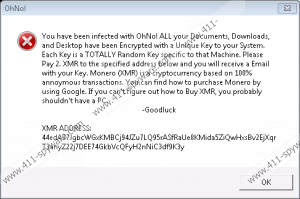OhNo Ransomware Removal Guide
Were you introduced to a “OhNo!” window with a message suggesting that your personal files were encrypted? If you were, the malicious OhNo Ransomware must have slithered in. According to the latest information, this threat is most likely to exploit spam emails to gain access to vulnerable operating systems. You must already know that opening spam emails is like asking for trouble, and that is because they are often used to promote scams and malicious links or attachments. Obviously, if you opened the file, and you know that it is responsible for unleashing the ransomware, you should have no trouble identifying it. If you can identify it, you can remove OhNo Ransomware, and that, of course, is incredibly important. In case the malicious ransomware appeared seemingly out of thin air, it is possible that it was executed without your knowledge at all, and it is possible that other infections are active. If they are, you must delete them without further hesitation, but, right now, let’s focus on the malicious ransomware.
The OhNo Ransomware window that shows up on the screen suggests that “Documents, Downloads, and Desktop have been encrypted,” which indicates that your personal files were encrypted. Whenever you get a notification suggesting that your files were corrupted, you must find your files and check if or not they were compromised. There are many infections that simply fail to encrypt files or that use scary notifications just to make you think that files are corrupted. The good news is that the “OhNo!” window can be closed, and so checking the status of your personal files should not be difficult. According to the intimidating message, you need to pay a ransom of 2 XMR (~210 USD) to receive a decryption key to your email. First of all, how can they transfer the key to your email address if you are not asked to disclose it? That is a good sign that the transaction will not go as promised. Even if you had the chance to share your email address, you should not pay the ransom or do anything else because a decryption key is unlikely to be offered anyway. Of course, since you cannot recover your files by deleting OhNo Ransomware, you might see no other option but to take the risk.
The current version of OhNo Ransomware does not encrypt files, but our research team warns that the threat has the potential to do that. If the encryption happens, the files should get the “.ohno” extension appended to their names. Recently, a ton of dysfunctional ransomware threats were found. Such threats as Kappa Ransomware, Ev Ransomware, or Gg Ransomware are all unable to encrypt files right now, but that does not mean that these threats will remain helpless. Unfortunately, by the time you are reading this, the malicious OhNo Ransomware might have been made stronger, and it is now capable of encrypting files. If that is the case, the most important thing for you is likely to be the recovery of your personal files. As mentioned already, it is unlikely that you can achieve that by paying the ransom, but you might have backups. Do you store copies of your files online or on external drives? If you do, you should not hesitate to remove the ransomware much longer. If backups do not exist, it is possible that your files are lost for good, and recovering them is impossible.
Have you paid the ransom, and your files are now encrypted? As we discussed previously, this is unlikely to be the scenario; however, even if things work out this way, you still need to remove OhNo Ransomware. Whether or not you recover your files, this malicious threat remains active, and failure to delete it could lead to other security problems. Although some users might be able to get rid of this threat manually, we have to warn that this task is not always simple. Sure, if you can find the launcher, erasing it is a piece of cake; however, if the file is hidden, you might feel like looking for a needle in a haystack when trying to uncover it. So, what is the solution to this problem? Anti-malware software. If you install legitimate software, it will automatically delete OhNo Ransomware along with any other threats that might exist on your PC.
How to delete OhNo Ransomware
- Find the {unknown name}.exe file that represents the launcher of the ransomware.
- Right-click and Delete the file and then Empty Recycle Bin.
- Perform a full system scan to check if you need to delete any other malicious components.
OhNo Ransomware Screenshots:


